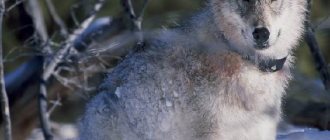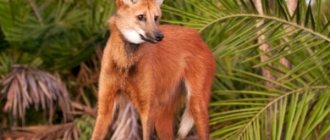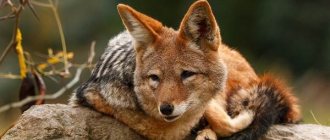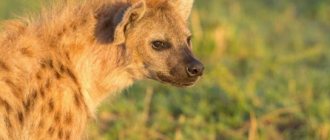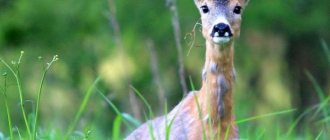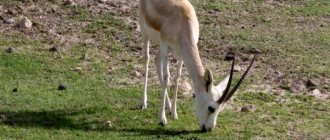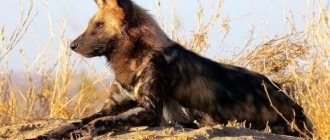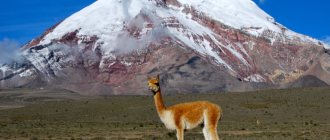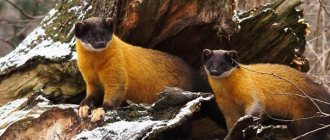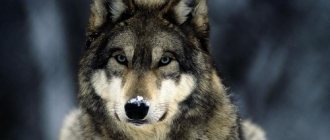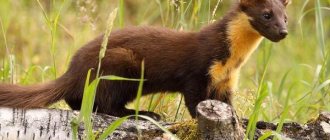The wolf, as a beautiful and proud animal, has firmly entered the mythology of many peoples of the world. In Russian fairy tales, he is a faithful and devoted assistant to the main character. The appearance of this animal is beautiful in itself, but how graceful it is in movement. Wolves are able to reach speeds of up to 60 kilometers per hour, and cover 80–90 kilometers during the night. Let's take a look at this amazing representative of the earth's fauna and before us are the most beautiful wolves that have ever lived or are living on our planet.
The freedom-loving and independent animal has become the hero of many literary, artistic works and, of course, films.
In the zoological system, the wolf is a fairly large mammal from the canine family, and, moreover, as recent DNA studies show, it is a direct relative of the domestic dog.
The most beautiful wolves on the planet:
1
Mackensian wolf
North America is an amazing continent. Many animals took refuge there, including the Mackensian representative. This type of wolf is often depicted in photographs with a bloody muzzle. Such an animal is considered one of the most bloodthirsty lowland hunters.
His massive body helps him kill animals quickly and without problems, or rather, a strong torso and long paws that can walk even in difficult areas. The respiratory system of this species is well developed. Even after walking 100 km, the Mackenzi wolf will not encounter the problem of shortness of breath.
The nose is a part of the animal’s body that is vulnerable to cold, therefore, during sleep, it often covers it with the hair of its long tail. This allows the animal to stay warm. The sternum of the Mackenzi wolf is covered with light hair, and the back and tail are darker.
This hunter always stalks the game with his brothers. Typically, in one group of Mackenzi wolves there are up to 10 individuals. Packs attack mainly large herbivores, such as moose or bison.
Newfoundland Wolf
Photo: Approximate image of a Newfoundland wolf.
A wolf with an unusual color was found on the islands off the east coast of Canada. The unusual thing was the dark, almost black stripe running down the back of this graceful wolf.
Scientists have recorded that the last time a wolf of this species was seen was in 1911.
Hunting and fur farming in this part of the Earth led to the extinction of the Newfoundland Wolf. Human hunting for animals included in the wolf's diet and active settlement of the islands by humans led to the extinction of this subspecies.
Red Wolf
This is a very rare species of wolf , found in the mountains of South and Central Asia. The individual is specific for its red fur. Some species of red wolves are endemic to specific areas. They have another name - “buanzu”.
The red wolf is very similar to the jackal and fox. This is a large and very fluffy predator. The animal's tail is so long that it has to be dragged along the ground. On the dorsal and caudal areas of the body you can see black fur, but there is little of it. Buanzu is born not red, but brown. As the wolf cub grows older, it brightens.
As the weather changes, the animal's fur changes. In summer it is quite rough, but in winter, on the contrary, it is gentle and soft. Also in the cold season, it becomes a little lighter. The appearance of the red wolf depends significantly on its habitat.
For example, individuals found in Indochina have the longest and softest fur, while “Pakistanis” and “Afghans” have short fur. An interesting feature of the species is the smallest number of teeth among all wolves.
Wolf diet
Wolves obtain their food by hunting, which involves searching for and pursuing prey. Mostly ungulates are what wolves eat. Wolves may attack domestic animals. They can feed on eggs and rodents.
Also, raccoons, foxes or sleeping bears can become victims of the predator. They do not refuse plant foods either. They are practically omnivores. They need plenty of water to drink.
When hunting, wolves behave very quietly, almost silently, so as not to scare away the prey. Excellent hearing, excellent sense of smell and vision, combined with strength, speed and endurance, make the wolf an extremely successful hunter.
Attacks by a pack of wolves on herds of animals are possible, with several individuals becoming victims.
The animal has a highly developed art of pack hunting.
polar Wolf
The home of this beautiful white wolf is the Arctic, which is why many zoologists also call it “Arctic”. The animal is not at all afraid of low temperatures; long, thick fur protects it from them. The animal's fur is so dense that it is not afraid of even cold rain and strong winds.
The biological reserves of food for this species in the Arctic are quite scarce. For this reason, when an animal kills its prey, it rarely leaves its meat “in reserve”; it completely tries to eat it. By the way, the polar wolf has established itself as an excellent hunter. A well-developed sense of smell and excellent eyesight help him in searching for prey.
It is known that due to lack of food, he can starve for 1 to 2 weeks. Why is this beautiful wolf at the stage of extinction? There are 2 reasons:
- The melting of Arctic glaciers, provoked by global warming on the planet.
- Increased attention of hunters to the snow-white fur of the wolf.
Description, structure, characteristics
All wolves are notorious predators, there are no options here, and they are quite large predators, the largest being the gray and polar wolves: their height reaches 85 cm, body length - 150-160 cm, this does not include the tail, weight - 85-90 kg . Moreover, the harsher the habitat, the larger the animal; it is not for nothing that the largest representatives of the wolf family live in the Siberian taiga.
The smallest wolves are Arabian, their maximum height does not exceed 66 cm, and their average weight is only 10 kg. Also, in general, in all wolves, females are slightly smaller in size than males.
Outwardly, wolves look like dogs, which is not surprising, because they are their distant relatives.
The wolf's mouth has 42 teeth, including four fangs, which serve the owner to tear prey into pieces, grind bones, and the fangs are excellent for dragging the victim.
Interesting fact: all wolves are born gob-eyed, but by the third month their eyes turn orange or golden yellow. Although there are wolves who remain blue-eyed.
Wolf fur is thick and double-layered; it perfectly protects them from the cold in the cold conditions of the tundra or taiga, and also has waterproof down.
Coat colors can vary depending on the type of wolf and its habitat, with a wide variety of gray, white, brown and black colors found. Red wolves are also found. Often their color helps them blend in with their surroundings.
You may know the proverb “the wolf’s legs feed him”; it also has scientific and zoological basis, since his legs really feed him, and for this reason they are well developed, allowing him to move considerable distances in search of food. Wolves usually trot at an average speed of 10 km per hour, but the speed of a wolf chasing prey can reach 65 km per hour.
A wolf's vision is not the strongest quality, it is not very developed, and besides, it does not distinguish colors, but this deficiency is more than compensated by excellent hearing and especially charm - it can smell prey 3 km away, in general, its nose distinguishes millions of shades of smell.
Also, another characteristic feature of wolves is their famous howl, which actually has a practical meaning for them - wolves do not just fight for the moon (as was previously thought) but in such a simple way inform the members of the pack of their location, and at the same time drive away strangers.
Marsupial wolf
Today, nowhere on Earth is the marsupial wolf found. This species is officially considered extinct. The body of such a creature reached more than 120 cm in length, and it weighed about 30 kg. It was found on the territory of modern Australia.
The appearance of the beast was more like a dog than a wolf. He had short but very thick fur. To the touch, it was quite rough. Stripes ran across the body of the marsupial wolf. In forest areas, such individuals chose caves as a sleeping place, and if they could not be found, then wooden hollows.
The marsupial wolf almost never united with other individuals to form packs. But there were known cases of these animals living in pairs. The beast's voice was very different from the voices made by other wolves. It was somewhat reminiscent of a cough, it was muffled and quiet.
Wolf family
As noted earlier, there is a hierarchy within a wolf pack. The roles are clearly distributed, and their own rules are established. This makes the pack a highly organized survival mechanism. Ranks in the wolf community depend on the age and sex of the animal. Influence occurs through authority, but for each wolf there is freedom of choice - he can leave the family at any time.
Ranks in the pack:
- Leader (alpha male). Takes the main role, distributes responsibilities, leads the hunt, chooses habitat. The leader of the pack has the undeniable advantage of being the first to start eating the prey. This rule can be violated by the leader himself. During periods of food shortage, he can offer the first portion to the puppies, since they are the successors of the family and future leaders.
- Alpha female. This is the leader's girlfriend. She is the head of all females in the pack, but also obeys the alpha male.
- Beta male. This is the receiver. He does not have the rights of a leader, but may not obey him and often declares his right to become the leader.
- Warriors. Strong, healthy individuals. They are the first to engage in battle at the leader’s signal. They take part in the hunt and can be of any gender. They provide food and safety for the entire flock.
- Mother. An adult female experienced in raising offspring. Its main role is to raise all the puppies of the pack. Not all whelped females occupy this rank. If there is danger, the mother protects the offspring by taking the puppies to a safe place.
- A guardian is an animal that is subordinate to its mother and helps raise the puppies. Very often this is a young wolf (pestun), who has not reached the rank of warrior, or an adult wolf who does not have a mate or a family of his own.
- Signalman. He is the “eyes” of the flock and warns of an impending threat. The signalman transmits information to the leader and warriors, and they decide to attack.
- Puppy. Adults raise and care for the young. The puppy must obey and obey adults.
- Disabled person. Frail elderly wolves. The pack always treats old relatives with respect, feeds and takes care of them.
dire wolf
Another extinct species of wolf. This is a huge animal, whose body reached more than 1.5 meters in length. And it weighed more than 60 kg. Its habitat was North America. The terrible one differed from the gray wolf in its larger body size and strong legs.
It was one of the main hunting objects of primitive people. It is difficult to say exactly who the dire wolves themselves hunted. However, there is an axiom in zoology - the body weight of a predator’s victim cannot be greater than the total weight of all members of the flock attacking it.
Based on this, we can conclude that during the life of the dire wolf, he attacked mainly bison, whose body weight exceeded 300 kg. But a flock of these strong animals could not feast on bison every day, so they often ate large aquatic mammals washed ashore.
Extinct wolf species
Since ancient times, wolves have been endowed with demonic powers. It is not for nothing that the image of gray was attributed to the dark essence of man. This is how the mythical character appeared - the werewolf. It does not belong to the official species of grays, and the existence of wolf-people has not been proven. Another question is the existence of 8 ancient species of predator. Their existence has been proven through skeletal finds, drawings and records from bygone eras.
dire wolf
This predator lived back in the late Pleistocene. This is one of the eras of the Quaternary period. It began 2.5 million years ago and ended 11 thousand years ago. So primitive people hunted dire wolves. The animal became extinct during the last ice age. There were several of them during the Pleistocene. The latter was distinguished by the severity of the frosts.
The appearance of the dire wolf corresponded to its name. The predator was one and a half meters long and weighed over 100 kilograms. Modern wolves are never larger than 75 kilos, that is, at least a third less. The bite force of prehistoric ones was just as superior to the grip of modern grays.
There lived a dire wolf in North America. The remains of the animal were found in Florida, Mexico City, and California. Wolves from the east and center of the continent had longer legs. Skeletons found in Mexico City and California have short legs.
Kenai wolf
That's who should be called terrible. However, the remains of the Kenai Gray were found later than the prehistoric one. The animal, which once lived in Alaska, reached a length of 2.1 meters. This does not include the 60 cm tail. The height of the wolf exceeded 1.1 meters. The predator weighed about a hundredweight. Such dimensions allowed the predator to hunt moose.
The existence of the Kenai Gray was established by studying wolf skulls found in Alaska. According to research, the species was described in 1944 by Edward Goldman. This is an American zoologist.
The Kenai wolf became extinct by the 1910s. The beast was exterminated by settlers who arrived in Alaska. Predators died while being hunted and due to the use of strychnine by people. It is obtained from the seeds of the cherry grass and is used to kill rodents.
Newfoundland wolf
He lived not only on the island of Newfoundland, but also on the east coast of Canada. When describing the criteria for a wolf species , it is worth mentioning first of all the black stripe along the ridge on a snow-white background. The indigenous people of Newfoundland called the predator Beothuk.
The Newfoundland gray was exterminated by settlers. For them, the predator was a threat to livestock. Therefore, the government set a reward for the killed wolves. Each one was given 5 pounds. In 1911, the last island gray was shot. The species was officially declared extinct in 1930.
Tasmanian marsupial wolf
In fact, he was not a wolf. The animal was compared to the gray one due to its external resemblance. However, the Tasmanian predator was a marsupial. Still premature cubs “came out” into the skin fold on the abdomen. In the bag they developed to the point where they could go out into the world.
Transverse stripes ran along the back of the Tasmanian wolf. They encouraged associations with a zebra or a tiger. In terms of body structure, the marsupial resembled a short-haired dog. The official name of the species is thylacine. The last one was shot in 1930. There were still a few animals left in zoos. The Tasmanian wolf lived there until 1936.
Japanese wolf
He was short-eared and short-legged, lived on the islands of Sikoko, Honshu and Kyushu. The last animal of the species was shot in 1905. 5 stuffed Japanese wolves have been preserved. One of them is exhibited at the University of Tokyo.
The other four stuffed animals are also in Tokyo, but in the National Museum. The Japanese type of animal, the wolf, was medium-sized. The body length of the predator was no more than a meter. The animal weighed approximately 30 kilos.
In the 21st century, Japanese scientists reconstructed the genome of the extinct wolf. Protein compounds were isolated from the enamel of the teeth of the disappeared animal. The fangs were taken from the skeletons found. Squirrels were planted on the skin of modern wolves. It turned out that the genome of island grays differs by 6% from the DNA set of continental individuals.
Mogollon mountain wolf
The Mogollon Mountains are located in Arizona and New Mexico. A wolf once lived there. He was dark gray with white markings. The length of the animal reached 1.5 meters, but more often it was 120-130 centimeters. The Mogollon predator weighed 27-36 kilograms. The species was officially declared extinct in 1944. Compared to other wolves, the Mogollon was long-haired.
Rocky Mountain Wolf
Also an American, but he already lived in the mountains of Canada, in particular, the province of Alberta. Part of the population lived in the northern United States. The color of the animal was light, almost white. The predator was medium in size.
Glacier National Park is located in Montana. The name translates as "Glacier". The area is cold. It was the first in the world to be recognized as an international park. This happened in 1932. Well, there are reports of several wolves living in Glacier that fit the parameters of a Rocky Mountain predator. There is no official confirmation of the information yet.
Manitoba wolf
Named after the Canadian province of Manitoba. Representatives of the extinct species had thick, light, long fur. Clothes were made from it. Also, the skins of Manitoba predators were used to decorate and insulate homes. This served as an additional incentive to shoot predators that were attacking livestock.
The Manitoba wolf was artificially recreated in Yellowstone National Park. However, experiments with the genetic material of an extinct predator made it possible to create a “double” rather than a “twin.” The genome of the modern Manitoba gray differs little from the real one.
Wolf of Hokkaido
Otherwise known as Ezo, he lived on the Japanese island of Hokkaido. The predator was distinguished by a large skull with large and curved fangs. The size of the animal exceeded the parameters of the island Japanese gray, approaching those of an ordinary wolf.
The Hokkaido wolf's fur was slightly yellowish and short. The predator’s paws were no different in length. The last representative of the species became extinct in 1889. The cause of the death of the population was the same shooting, “fueled” by government rewards. They got rid of wolves by actively plowing the lands of Hokkaido for farmland.
Florida wolf
He was completely black, thin, with high legs. In general, the animal resembled a living red wolf, but of a different color. From the name of the animal it is clear that it lived in Florida. The last individual was shot in 1908. In addition to hunting, the reason for the extinction of the species was its displacement from its habitat. The Florida wolf preferred the American prairies.
Ethiopian wolf
The appearance of a wolf is most similar to a fox. This individual has a light red tint of fur; there is white delicate fur under the tail on the paws and the front of the neck. The ears of the animal are oblong and wide. It is endemic to Ethiopia, an endangered wolf species . This is not connected with hunting, but with a banal loss of genetic uniqueness, because this animal often crosses with African dogs.
The animal is very fast and agile. Long limbs help him gain impressive speed of movement. The Ethiopian wolf does not attack large game; it is only interested in small forest animals, such as hares, rats or mice. The largest animal that such a predator dares to attack is an antelope.
What does a wolf eat and how does it hunt?
The wolf is a picky predator. The main diet of the common wolf includes large ungulates: deer, elk, saigas, sheep and goats. But the wolf also eats hares, various rodents and birds, because he is not picky. Sometimes wolves can eat dead members of the pack.
Large concentrations of livestock attract wild and predatory wolves. Therefore, it is common to encounter a gray wolf near farms. The wolf eats meat, so on average the animal requires 3-4.5 kg of meat per day. Wolves store their food. Having had enough, the animal wolf buries the remaining pieces of meat. Wolves can go without food for more than two weeks. In the summer, the diet of the common wolf includes plant foods, so in the summer the wolf also eats fruits and berries.
The principles of wolf hunting are very diverse. In winter, wolves hunt collectively for large ungulates. Wolves use this type of hunting in winter. The main advantage of a wolf's winter hunting is the presence of snow cover, on which it can easily move. Snow makes it much more difficult for ungulates to escape from a wolf, a wild and predatory animal.
It is curious that the collective hunting of wolves involves the distribution of responsibilities: part of the pack participates in the pursuit of prey, while the other cuts off the path of the prey. When hunting, the wolf's nose is the main adviser. He tells the wild predator where to look for prey. Wolves can smell even a small animal that is a couple of kilometers away from them. It is with the help of their acute sense of smell that wolves can follow the tracks of their prey. The wolf hunts almost silently.
The wolf's main weapon is its teeth. With sharp fangs 5 cm long, the wolf holds and drags the victim, and with the remaining teeth it cuts up the game. A wolf’s teeth are not only its weapon, but also its protection, so their loss is disastrous for the animal.
Wolves kill especially large ungulates by attacking as a whole pack and attack until their prey falls. At the same time, the primacy to feast on the prey rightfully belongs to the leader and his female; they eat the best pieces of the carcass.
The wolf hunts very carefully. Stealthily sneaking up on the animal, with a deft leap he grabs it by the throat and throws it to the ground. It can sit in ambush for hours and wait for prey all day long. Often they can follow a herd of ungulates; predators do not give away their presence, but wait for the right moment to attack.
Wolves are very cunning; in pursuit they stop pursuing, allowing the prey to go far ahead. When the victim slows down, the wolf attacks again. Wolves often attack foxes. But most often they don't eat them. By attacking a herd of livestock, wolves can distract dogs. Part of the wolf pack attacks the dogs, and the rest attacks the herd.
Wolves are very good at navigating the terrain. Many packs use the same areas of territory to drive prey into a dead end. When hunting rodents, the wolf jumps on the prey, crushes it with its paw and eats it. This hunting technique is common for wolves in the summer.
In summer, the flock splits up and predators live alone or in small groups. Wolves feed on a variety of animals, using well-established hunting techniques. In the summer, the wolf most often feeds on hares. But even with all the calculated moves and deft maneuvers in the hunt, it does not always end successfully.
Maned wolf
The animal received this nickname because of its long, delicate fur, reminiscent of the mane, not of a lion, but of a horse. Short fur is present only on the limbs of the individual. The maned wolf is found in several countries in South America, including Brazil.
The color of the animal's fur is red, but there are dark areas on the paws, neck and tail. The maned wolf prefers to settle in dense forest areas where there are tall plants. The main specific feature of this species is its long limbs. This is one of the few species of wolves that likes to hunt on its own, without its fellows.
The animal quietly sneaks through the thickets to silently get close to the prey, and then runs out sharply, attacking it. In addition to small animals, the maned wolf eats birds and fruits. Very rarely, it will team up with other wolves to attack livestock. Such an animal is classified as “family” (monogamous). It is interesting that the cubs of the maned wolf turn red over time. They are born brown or black.
Lifestyle of wolves
Wolves are active mainly at night, but sometimes they can be found during the day.
They make their presence known by a vocal howl, which is very different in character among adult males, she-wolves and young ones, and also depending on the situation. The fact is that with the help of various kinds of howls, wolves exchange information about the presence of prey, the appearance of other wolves in the territory of the pack, the appearance of people and other important events. Wolves also have quite developed facial expressions - the expressions of their muzzle, posture and tail position can be very diverse, which reflects the emotional state of the animals and is of paramount importance for establishing contacts between individuals or, conversely, preventing collisions. Of the analyzers in wolves, the most developed is hearing, some weaker are vision and smell. Well-developed higher nervous activity in wolves is combined with strength, agility, tirelessness, running speed and other physical characteristics that significantly increase the chances of this predator in the fight for survival. Without visible effort, he can carry a sheep in his teeth, holding it in front of him or throwing it behind his back. If necessary, the wolf reaches speeds of up to 55-60 kilometers per hour, capable of traveling up to 60-80 km. per night, and on average per day (in the forest zone) to cover over 20 km. In the tundra, as well as in the mountains, wolves carry out seasonal migrations behind herds of wild and domestic ungulates. Sometimes there is a noticeable increase in the number of wolves in a certain area as a result of a sharp deterioration in living conditions in neighboring areas. Migration of wolves in search of new territories In a wolf pack there is a strict hierarchical ladder, which is determined by a very complex set of relationships in the pack, the age of its members and feats in hunting. The least respected are young wolves, who occupy the lowest places in the hierarchy; they are the ones who often fight off the pack, showing pride and impatience with oppression from their older brothers. Such wolves migrate from the territory occupied by the pack over quite long distances in search of the same tribesmen or smaller packs with weaker leaders and available lone wolves. Lone wolves move carefully, avoiding encounters with humans, but not necessarily at night. Along the way, the wolf stops to hunt, often for livestock. When meeting lonely brothers, they flock into small flocks and continue their journey in search of free territories and rich hunting grounds. In this case, a pack of migrating wolves can consist of up to three or five individuals. When united in a pack, wolves often attack shepherds and enter small villages, but only when they have no luck in the hunt for a long time. A meeting between migrating wolves and a pack of fellow tribesmen can result in trouble for a weaker enemy. Thus, going through difficulties and trials, wolves explore new territories, sometimes running hundreds of kilometers.
Click here to hide text
We recommend: Wood sealant: how to use?
Wolf hunting. How wolves divide territory
Click here to see hidden content
Tundra wolf
Light long fur is what makes the tundra wolf stand out from other animals. Found in Russia. The size of the body is slightly inferior to the Arctic one. This species is also called Siberian.
To be completely satisfied, the animal must eat at least 10 kg of meat. But such luck is very rare for him. When the animal does not come across large game, it can feed on a rodent or hare.
In Siberia you can find a brown tundra wolf, but there are few of them; light ones are more common. This type of wolf in Russia is considered one of the most careful. The animal always avoids people.
Current species of wolves
In fact, there are not 7, but 24 existing wolves, since the ordinary gray has 17 subtypes. We will separate them into a separate chapter. For now, 6 self-sufficient and “lonely” species of wolves:
Red Wolf
The red wolf is a species that has absorbed the external characteristics of not only the gray wolf, but also the jackal and the fox. The latter is reminiscent of the red color of the fur and its length on the back and sides of the predator. In addition, the wolf has a narrow muzzle, like the red cheat. The long, fluffy tail of the red predator also resembles that of a fox. The body structure is closer to a jackal, just as lean.
Around the eyes, nose and at the end of the tail of the red wolf, the fur is almost black. Together with the tail, the length of the animal is 140 centimeters. A wolf weighs 14-21 kilograms. The red predator represents the species of wolves in Russia , but is listed as endangered on the lands of the Federation. However, outside the country the predator is also protected. Hunting is allowed only in India and only with a license.
polar Wolf
He's white. According to its name and color, the predator lives in the Arctic. In order not to succumb to the cold, the animal grew thick and long fur. The polar wolf also has short ears. This eliminates heat loss through large sinks.
Among the existing ones, the polar wolf is large. The height of the animal reaches 80 centimeters. Height is also 80, but kilograms. In conditions of food shortage, the polar predator goes without food for several weeks. Then the animal will either die or still get the game.
When hungry, an Arctic wolf can eat 10 kilograms of meat at a time. Food supplies in the Arctic are declining due to melting glaciers, climate change, and poaching. The number of polar wolves has also decreased. It is listed in the International Red Book.
Maned wolf
The name is due to the presence of a “necklace” of long hair on the wolf’s neck and shoulders. It is tough, reminiscent of a horse's mane. Like mustangs, the animal lives in the pampas and prairies. The main wolf population settled in South America. There is no animal beyond the ocean.
The maned wolf is lean and has high legs. The latter property allows the animal not to “drown” among the tall pampas grasses. You need to look out for prey, and to do this you need to be above the “situation.”
The predator's coloring is red. Unlike the Arctic wolf, the maned wolf has large ears. At the same time, an American is comparable in height to a resident of the Arctic Circle, but weighs less. On average, a maned wolf weighs 20 kilograms.
There is no threat of extinction of the species yet. However, the maned wolf is listed in the International Red Book as endangered. The status indicates a declining population of a still thriving species.
Ethiopian wolf
matter how many species of wolves you look at, you won’t find anything more similar to a fox. The animal is red, with a long and fluffy tail, large and pointed ears, a thin muzzle, and high paws.
The predator is endemic to Ethiopia, meaning it is not found outside of Africa. Before the DNA test, the animal was classified as a jackal. After research, it turned out that the genome of the predator is closer to wolves.
Compared to jackals, the Ethiopian wolf has a larger muzzle but small teeth. The height of the African predator at the withers is 60 centimeters. The length of the animal reaches a meter, and the maximum weight is 19 kilograms.
The Ethiopian wolf is recognized as a rare species and is listed in the International Red Book. The species' extinction is partly due to interbreeding with domestic dogs. This is how the genetic uniqueness of wolves is lost. Among other reasons for extinction, the main one is human development of wild territories.
Tundra wolf
The least studied of the existing ones. Externally, the animal looks like a polar predator, but is not as big in size, weighing no more than 49 kilograms. The height of large males reaches 120 centimeters.
Females are inferior to the stronger sex in height, weight, but not body length. The thick fur of the tundra wolf consists of guard hairs approximately 17 centimeters long and downy undercoat. The layer of the latter is 7 cm.
Spanish wolf
The small red-gray wolf, as the name suggests, lives in Spain. The species was declared extinct, but scientists were able to find several surviving individuals. Spanish wolves have white markings on the lips and dark ones on the tail and front legs. In other respects, the predator is similar to the common wolf. Many scientists consider the Spaniard to be its subspecies.
Mongolian wolf
This type of canid is much smaller than the tundra one. The maximum weight of the Mongolian wolf is 38 kg. Light gray fur predominates on the body of the animal. They live in Russia, in the Primorsky Territory.
The Mongolian wolf is a very hardy animal. He can stalk his prey for several hours. The hunt of such predators often ends with their prey falling exhausted to the ground. Then the wolves pounce on her. The mechanism of their pursuit is interesting in that they slowly run after each other, in one long column.
Steppenwolf
In general, somewhat smaller than the forest one, with sparse and coarser hair. The color on the back is with a noticeable predominance of rusty-gray or even brown hair, and the sides are light gray. Its range includes the steppes of southern Russia, including the Cis-Caucasian, Caspian, Ural and Lower Volga regions. Poorly studied. A system of specific characteristics has not been developed. The number is low, especially in the western parts of the range.
Red wolf
Zoologists are still arguing about the classification of such an animal. Some believe that the red wolf is a species of gray wolf , while others believe that it is a separate type of canid. There is also a version that this predator is a hybrid of a coyote and an ordinary wolf.
Today this beast can be found in some American states, for example, in Texas. Their population is small, so the species is considered endangered. The animal's coat color is reddish-gray. But in Louisiana you can find darker representatives of this species. They have medium-length fur, long ears and strong slender paws.
In terms of habits and food preferences, the animal is no different from its “gray” brother. Just like the gray wolf, the red wolf prefers to live next to its relatives. However, such an animal does not create large groups. Each pack of red wolves includes no more than 8-10 individuals. This predator is monogamous.
While the pack goes hunting, the weakest wolf remains to look after the brood. By the way, red wolves feed mainly on raccoons and medium-sized rodents. Very rarely they manage to catch and eat large prey, such as elk.
Wolf Ancestors
According to the theory of evolution, the ancestor of the wolf was Canis lepophagus, an ancient mammal resembling a coyote and living in North America. Over time, the wolf's ancestor increased its size, including the size of its skull. The most ancient representative of the wolf family, already similar to the modern wolf, was found during the study of an early pleistocyte that existed 1.8 million years ago. Although he was only similar to the modern wolf, which was somewhat later - from a million to 150 thousand years ago.
In general, zoologists have discovered as many as four family trees of wolves: African, Himalayan, Indian and Tibetan lines. The Himalayan line is the oldest of them, which means that the Himalayan wolf is the most venerable representative of the wolf order, its appearance took place about a million years ago. The Tibetan wolf is conditionally the “youngest”, since it appeared “only” 150 thousand years ago.
Eastern wolf
In zoology, there are a large number of versions regarding the classification of this canine species. According to the most common opinion, the eastern wolf is a hybrid of a red and gray wolf. This animal lives in the Canadian province of Ontario.
This predator is not one of the large ones. Its body measures up to 80 cm. It has a gray-yellow color. The animal's fur is very thick and dense. The eastern wolf is a social animal, but does not like to form large groups. One flock can contain no more than 3-5 individuals.
This type of predator is considered not only an excellent hunter, but also an excellent guard. If another animal wanders into the territory of the eastern wolf, it will certainly be attacked by all members of the pack. In deciduous forests, animals often hunt beavers and large mammals such as moose.
Lyry Wolf
Not yet classified as a separate subspecies. The wolf has been spotted in South America.
Information about the Lear Wolf and its photograph first appeared in 2009. Zoological scientists can neither prove nor disprove the existence of this species of wolves.
As you can see, the animal has an unusual black coat color with a fluffy tail, is short on its legs and looks like a large dog.
3
Melville wolf
The animal's habitat is the island of Greenland. The Melville wolf weighs no more than 45 kg, however, some individuals reach 70 kg. Gray and white Melville wolves can be found on the island of Greenland. Their fur is quite thick and long. The specificity of the species is small ears.
One individual will not be able to kill large prey, therefore, for this species there is a need for unification. Melville wolves hunt in groups of 6-9 individuals. Usually, animals track a herd of bulls or sheep, watch them and determine the weakest one.
The fact is that a strong, large animal can begin to resist and even attack the wolf in response. He knows this, therefore, he never fights with such people. Melville wolves spend the night in shallow rocky caves. The living conditions of such an animal are truly harsh. This is reflected in its numbers.
Reproduction and raising of offspring
Sexual maturity in forest predators occurs when they reach 2 years of age. But, given the fact that wolves form long-lasting married couples, and at the same time choose a life partner for a long time, their first offspring appears no earlier than they are 3-4 years old.
Some wolves never become parents at all, because they could not find a suitable partner for themselves, and casual sex is not typical for them. Such lonely predators live on their own, or join some kind of pack, joining the ranks of warriors.
In wolves, the breeding season occurs only once a year and is strictly seasonal. Mating games of gray predators begin in January and last until March, so the birth of cubs occurs in favorable warm months, when the forests are full of game.
Features of the mating season
A peaceful and calm environment usually reigns in a wolf pack, but with the onset of mating season, tension increases in the clan of predators. The dominant pair fiercely protects each other from other family members and lone wolves. If there are already married couples in the pack, they also have to protect their partner from the attacks of their rivals. Well, predators who have not yet acquired their own pair are actively starting to search for their soul mate.
Couple of wolves in love
Wolves, on an intuitive level, avoid sexual relations with their close relatives, therefore individuals from the same brood never enter into a marriage union with their brothers and sisters. In most cases, young wolves generally look for a permanent partner among members of other packs.
There are many more males among wolves, so for one free she-wolf, from 2 to 5 suitors apply. An honorary escort of gray admirers gathers near young females and mature females (including widowed she-wolves), but not everyone has a chance to get a lady of their heart. Of course, males have to fight among themselves, and sometimes their fights are so fierce that they end in the death of one of the rivals. And what’s most interesting is that there is no guarantee that the winner will get the she-wolf. After all, the final decision remains with the female, and if she doesn’t like the gentleman, she won’t let him get close to her.
And when the knightly tournaments and brutal fights are over, wolf couples in love begin to look for a secluded place to be alone and find a safe lair for their heirs. From this moment until the birth itself, the male gallantly looks after his chosen one, not hesitating to express his feelings for her with affectionate touches and romantic “serenades”. As soon as the she-wolf becomes pregnant, the future father becomes even more caring and protects her from any threat. Well, the female responds to her husband with the same love, tenderness and devotion, and tries to spend all her free time with him, because after the babies are born, her attention will belong exclusively to the newborn wolf cubs.
Dingo
Until now, biologists have not come to a consensus regarding the classification of dingoes. Some believe that the animal is a feral dog, in no way related to the wolf, while others believe that the dingo is a completely independent “wolf” species. One way or another, there is a version that he is a descendant of the Indian wolf, and a purebred one. Therefore, this animal is discussed in the article.
The species is widespread in Australia and Asia. Dingo is even found in New Guinea. It is a well-built, nocturnal predator with dense red fur. But the dingo also has white hair on its body (on the edge of the muzzle, tail and sternum). In New Guinea, there are also dark dingoes, with brown or even black fur.
Despite its "canine" nature, this type of animal never makes a sound reminiscent of a dog barking. But he howls by analogy with a wolf. This red animal settles near a pond. As a place to spend the night, dingoes choose large wooden hollows, holes or caves.
Interesting! Asian representatives of this species are not afraid of people, but, on the contrary, prefer to stay close to them. The fact is that people often feed dingoes. By the way, the red wolf-dog unites with its own kind, creating small groups. Only the leader and his female have the right to reproduce.
Reproduction
The mating season for wolves lasts several months (from approximately January to April). At this time, animals become aggressive. As a rule, there is one permanent pair in a flock - the leader and the main female. During the mating season, they are very aggressive towards other members of the wolf family and do not tolerate competitors.
The remaining males court other females. When couples have formed, each of them looks for a secluded place for conceiving and breeding offspring (den). During this period, the male is very attentive to the female. He senses the approach of estrus by the pheromones released. On a certain day mating occurs.
The she-wolf bears her offspring for about two months. One female can give birth to from 3 to 13 babies. Wolf cubs are born blind. They become sighted in about two weeks. After birth, they feed on their mother's milk. When the wolf cubs grow a little, they begin to feed them chewed meat. All members of the pack take care of the wolf cubs' food. However, in a hungry year, the main female can expel other she-wolves and their cubs from the family.
Central Russian forest wolf
This representative of predatory mammals is larger than the tundra wolf. The color of his dense fur is classic gray. The animal's sternum is lighter than its back. It has light fur. The average weight of a male Central Russian timber wolf is 40 kg.
This ferocious predator is found in the forests of Central Russia. In Altai you can meet huge Central Russian wolves, whose weight is even more than 70 kg. This is a very beautiful representative of its species, preferring to hunt, sleep and eat next to other individuals. The Central Russian wolf hunts large animals, for example, elk or deer.
In one group of such animals there are from 30 to 45 individuals. At one time, a female Central Russian wolf can give birth to up to 10 wolf cubs. She takes care of them, never losing sight of them. The male is responsible for searching for food.
Gray wolf and its varieties
The seventeen subspecies of the gray wolf is a relative number. Scientists are arguing about the separation of this or that population from others. Let's get acquainted with the subspecies that have clearly “defended” their right to a separate place in the classification. Six of them are found in Russia:
Russian wolf
It lives in the north of the country, weighs from 30 to 80 kilograms. Females are approximately 20% smaller than males. One day, hunters shot an 85-kilogram predator. Otherwise, the Russian wolf is called an ordinary wolf and does not need any introduction to its appearance. As for the temperament, domestic grays are more aggressive than similar animals from America. Some individuals of the common wolf are black in color.
Siberian wolf
Typical not only of Siberia, but also of the Far East. There are not only gray, but also ocher individuals. Their fur is thick, but it cannot be called long. The size of the Siberian is not inferior to the ordinary one. Only the sexual dimorphism between males and females of the subspecies is less pronounced.
Caucasian wolf
Among Russian wolves, its fur is the shortest, coarse and sparse. The animal itself is small, rarely weighing more than 45 kilograms. The color of the Caucasian predator is gray-ochre. The tone is dark. Siberian and common wolves are light gray, and thujas are almost black.
Central Russian wolf
This gray wolf looks menacing. Representatives of the subspecies are larger than tundra wolves. The body length of the Central Russian gray reaches 160 centimeters. The height of the animal is 100-120 centimeters. The Central Russian wolf gains weight of 45 kilograms.
The subspecies is typical for the central regions of Russia, occasionally entering Western Siberia. Preference is given to forests. Therefore, there is an alternative name for the subspecies - timber wolf.
Mongolian wolf
Among those found in Russia, it is the smallest. The predator lives in the forest-tundra of Kamchatka and Western Siberia. Externally, the Mongolian wolf differs not only in size, but also in the off-white tone of its coat. It is hard and rough to the touch. The name of the species is associated with its homeland. This is Mongolia. It was from there that wolves of the subspecies moved to Russian territories.
Steppenwolf
It has a rusty-gray color, tending towards brown. It is darker on the back, and lighter on the sides and belly of the animal. The predator's fur is short, sparse and coarse. The steppe subspecies of the gray wolf is typical of southern Russia, living in the Caspian lands, steppes in front of the Caucasus Mountains and the Lower Volga region.
It becomes clear why Russians call wolves gray. On the territory of the Federation, a gray tone is present in the color of all predators living here. However, in principle, wolves are both red and black. However, no matter what the color of the animal, the main thing in the social hierarchy is size. The largest individuals become the leaders of wolf packs. Usually these are males.
desert wolf
This species of wolf lives in Central Asian, Kazakhstan and Russian steppe and desert zones. There are grayish, red and gray-yellow individuals of the desert wolf. It is also called "steppe".
In terms of size, the strong animal is inferior to the gray wolf, however, it is just as strong and dexterous. A distinctive feature is quite hard fur. The body of the desert wolf is slender. This species has not yet been thoroughly studied.
Mackensen Wolf
A beautiful and fairly large wolf lives in the northwestern United States, Canada and the Alaska Peninsula. It also has a second romantic name - the Wolf of the Rocky Mountains.
The body structure is adapted for hunting in difficult terrain. Even in deep snow, the wolf develops great speed thanks to its powerful, strong limbs and developed shoulder girdle.
Mackensen wolves live in packs of 6 to 12 individuals, but there are also large packs of up to 30 wolves. Each pack hunts in a certain territory.
7
Caucasian wolf
There is such an animal in Russia. In a pack of Caucasian wolves, there is a clear hierarchical division of individuals. The authority of the leader, the main wolf of the group, is only questioned if he is injured or old. Then another male can challenge him. Caucasian wolves are clearly aware of their belonging to a specific group.
They are intolerant of those animals that do not agree to live by their rules. “Caucasians” have a belligerent attitude towards other canines. If one of the predators dared to cross their territory, he would be in trouble. The pack attacks the beast. The fur color of the Caucasian wolf is white-gray. Their ears and paws are medium in size. There are small black hairs all over the body of the animal.
Despite their warlike and aggressive disposition, Caucasian wolves are quite sensitive to their brood. Both parents take part in the process of raising wolf cubs. They not only good-naturedly encourage them, but sometimes severely punish them. Usually the reason for punishing a wolf cub is his excessive curiosity.
Lifestyle
Wolves are social animals. They live in flocks that can number up to 40 individuals. The smallest groups are 3 individuals. As a rule, a flock is one family. It contains animals of different ages, several generations. Wolves do not kill their relatives who can no longer hunt, but help them survive and feed them.
The pack has a leader. This is the wisest and strongest male. He has a pair - the main she-wolf in the pack. She is the head of the female species.
A pack of wolves has its own hierarchy. There is a leader who has unquestionable authority. He not only commands, but also takes care of each member of the pack. He always treats strangers extremely unfriendly, defending his territory.
The leader has a possible successor. It could be his son or brother. Such a successor may behave aggressively towards the leader, as if testing him for his readiness to give up his place.
If any wolf leaves the pack, he is called a loner. Most often, he strives to create his own pack. As a rule, this is a strong and healthy male.
Each flock has its own territory. You can only hunt on it. If wolves from another group or alone invade the territory of the pack, its members enter into a fight, fiercely defending their possessions.
The territory is usually marked. Claw and tooth marks can be seen on stumps and fallen trees. Like many other animals, wolves mark their territory with urine. The flock's domain can range from 50 to 1,500 km². Sometimes you can find a nomadic flock, usually not burdened with small cubs. In winter, wolves move one after another, trying to follow the trail of the one in front. Therefore, it can be difficult to determine the number of individuals in a flock.
Siberian wolf
Some zoologists were skeptical about the need to classify the Siberian wolf as a separate species. In terms of coat color, size and behavior, these animals are very similar to their closest cousins, Central Russian wolves. They are widespread in Kamchatka, Transbaikalia and Siberia. The fur of such an animal is very soft to the touch, like silk. They are thick and long. The fur of the Siberian wolf is lighter than that of the Central Russian wolf. The weight of the animal is up to 45 kg.
Eye color
All wolves have blue eyes at birth. But by the 3rd month it changes to gold. Although there are exceptions when wolves spend their entire lives with blue eyes.
Look - Saiga - habitat, lifestyle, species and characteristics of the artiodactyl. 110 photos of saiga in natural conditions
Iberian wolf
This is a very rare species of canine animal, which, until recently, was considered completely extinct. Lives in Spain and Portugal. The color of the animal's fur is reddish-gray. The Iberian wolf is much smaller than the Central Russian wolf. There are small white spots on its face, back and sternum. Because of this, the people called the beast “marked.”
Zoologists say that this type of wolf is very useful. The reason is to maintain the population of wood grouse, which in these parts are in danger of extinction. How does the Iberian wolf manage to do this? It's simple.
The animal hunts wild boar, which often pursues wood grouse. These animals hunt in small groups. Their prey is not only wild boars, but also roe deer, deer and sheep. Sometimes Iberian wolves eat fish.
Nutrition
The wolf is a predator. Therefore, the bulk of its diet consists of food of animal origin. However, wolves are omnivores. They can eat bird eggs, beached fish, and carrion. In hungry years, they do not refuse berries, mushrooms, fruits, insects, and frogs. Wolves hunt a lot of animals. Their menu includes:
- all the pets they can handle;
- raccoon dogs;
- many large wild animals (boars, roe deer, deer, foxes, even bears);
- various birds;
- small animals (gophers, jerboas, rats, hares, hedgehogs, badgers);
- reptiles (turtles, lizards, small snakes).
Wolves usually hunt in small groups, using various tracking and attack tactics, depending on the type of prey. An adult animal requires about 5 kg of meat per day. The minimum portion is 1.5 kg. If the prey is large and not eaten immediately, it is reliably hidden. The wolf is a very hardy predator. It can go without food for up to two weeks.
Common jackal
This small animal is also called “bark san”. The jackal is found in South Asia, however, not so long ago, it was widespread in some European countries, for example, in Albania. The jackal is very similar to a dog. It's smaller than, say, a dingo, or even a standard mongrel.
Its body weight is much less than that of the gray wolf, up to 20 kg. The jackal's muzzle is pointed and oblong, like a fox's. The fur of this "reduced wolf" is brownish-gray in color. In winter it becomes smoother. During the day, Kora San almost never eats, choosing to eat in the evening. He eats:
- Fish;
- Bird;
- Carrion;
- Snails;
- Frogs;
- Bugs;
- Berries;
- Snakes, etc.
It turns out that the jackal is practically omnivorous. He rarely hunts with his own kind. Despite its small size and lack of wolf endurance, a sharp mind and dexterity help the jackal to be a good hunter. It can silently sneak up on its prey and easily grab it before it can escape.
Habitat
The wolf is the most common predatory animal. In Russia, it lives throughout almost its entire territory. These animals inhabit forests, steppes, taiga, tundra, deserts, and the foothills of mountains.
Wolves also live in many European countries (Belarus, Scandinavia, the Baltics, Poland, the Balkans), in parts of Asia (China, Korea, Iraq, Iran, Georgia), and in North America (from Alaska to Mexico).
Wolves can live in any area, but they prefer to live in sparse forests and more open areas. Often they can be located close to human settlements, since there is always water near a person.
In what regions does the wolf live?
Currently, the habitat of wolves has been significantly reduced. This is due to their uncontrolled extermination in the past. Most of the predators are located in the territory:
- Russia;
- Belarus;
- Ukraine;
- northern part of the Arabian Peninsula;
- Afghanistan;
- Georgia;
- China;
- Korea;
- Iran;
- Hindustan;
- Iraq;
- Azerbaijan;
- Scandinavia;
- Baltics;
- Balkans;
- Italy;
- Poland;
- Spain;
- Portugal.
From Mexico to Alaska, the animals are common in North America. In Russia they live everywhere, except for the taiga, the Kuril Islands and Sakhalin. In Japan, predators have become completely extinct.
Wolves are able to live in a variety of terrain, but they give preference to places with weak forest cover. They often live close to humans. In the taiga, they accompany him and settle in the territory cleared of forest by people.
In the mountains, predators live as far as alpine meadows, where areas have little ruggedness.
The wolf is a territorial animal. During the cold season, flocks live sedentary. The boundaries of the territory in which they live are marked with odorous marks. In winter, the area occupied by predators is up to 44 km. However, as spring approaches, the flock breaks up into pairs. The strongest representatives remain on their territory, and single individuals lead a nomadic life. Wolves often accompany herds of livestock and deer.
To breed offspring, animals make dens. Most often they are natural shelters - thickets of bushes, depressions in the rocks. In some cases, wolves occupy the burrows of other animals - badgers, arctic foxes, marmots. It is extremely rare to dig them yourself. The she-wolf is most closely attached to the den during the period of raising the litter. The male does not use it. Puppies grow in well-hidden places: on hills, in ravines, near the shores of lakes covered with thick reeds, and in dense bushes. Wolves never hunt near their lair. After the puppies are strong enough for long journeys, the animals leave their shelter. For rest, they look for new, but well-protected places every time. The cubs look like dog puppies and have brown fur.
Range[edit]
Mongolian wolf
Assortment of C. l. Chanco
includes Mongolia, [3] northern and central China, [14] [15] Korea, [2] and the Ussuri region of Russia, into which they have recently expanded from northern China due to human settlement and the removal of their main competitor, the Amur tiger.
[12] Their range is limited in the east by the Altai/Tien Shan mountains with C. l.
lupus , [14] in the south near the Tibetan plateau by the Himalayan wolf, and in southern China by an as yet unnamed subspecies of wolf.
[14] [15] Authors of taxonomic synonyms described their specimens in the following localities: Chanco
Gray (1863), Chinese Tartaria;
coreanus
Abe (1923) Korea;
karanorensis
Matschie (1907) Kara-nor in the Gobi Desert;
niger
Sclater (1874) Hanle in the Indian Union Territory of Ladakh;
and tschillensis
Matschie (1907) off the coast of Chikhli. [5]
How long does a wolf live?
Since wolves belong to the canine family, they live approximately the same amount of time as dogs. But the lifestyle of wolves in the wild is very harsh and wolves die from disease, injury or lack of food before their time. In the wild, on average, wolves live 10-15 years. But with good care and proper nutrition, they can live up to 20 years.
Links[edit]
- ^ abc Gray, J. E. (1863). "Notice of Chanco or Golden Wolf (Canis chanco) from Chinese Tartary". Proceedings of the Zoological Society of London
: 94. - ^ abc Abe Yoshio, "Nukutei ni tsuite" (On Nuketei) Dobutsugaku zasshi
(Zoological Magazine) 35 (1923): 320-86 - ^ a b Mivar, S. G. (1890). "Common Wolf". Dogs, Jackals, Wolves and Foxes: A Canid Monograph
. London: E. H. Porter and Dulau & Co., p. 8. - Walker, B. (2008). Lost Wolves of Japan. University of Washington Press, Seattle. ISBN 9780295988146.
- ^ abc Pocock, R.I. (1941). "Canis lupus chanco" Fauna of British India. Mammals
.
2
. London: Taylor and Francis. pp. 86–90. - ^ ab Wozencraft, C. W. (2005). "Predator Squad" In Wilson, Delaware; Reader, D. M. (ed.). Mammal Species of the World: A Taxonomic and Geographical Guide. 1
(3rd ed.). Johns Hopkins University Press. ISBN 978-0-8018-8221-0. - Taxonomy Browser. "Canis lupus chanco Gray, 1863". NCBI
. Retrieved April 21, 2022. Genebank common name: Mongolian wolf - Taxonomy Browser. "Canis lupus laniger Hodgson, 1847". NCBI
. Retrieved April 21, 2022. GeneBank Common Name: Tibetan Wolf - L. Chen, H. H. Zhang, J. Z. Ma, Mitochondrial genome of the Mongolian wolf Canis lupus chanco and phylogenetic analysis of Canis. Acta Ecologica Sinica, 2010
- Zhang, Honghai; Chen, Lei (2010). "The complete mitochondrial genome of Cuon alpinus: phylogenetic analysis and dating of evolutionary divergence within canidae". Molecular Biology Reports
.
38
(3): 1651. DOI: 10.1007/s11033-010-0276-y. PMID 20859694. - M. Wrobel, ed. (2006). Elsevier Dictionary of Mammals. Elsevier. pp. 840–857. Qn1A9Y1OA2oC & pg = PA70 & lpg = PA70.
- ^ abc Geptner, V.G., Naumov, N.P. (1998). Mammals of the Soviet Union, Volume II, Part 1a, LILACIA AND COLLAR (sea cows; wolves and bears), Science Publishers, Inc. USA., pp. 164-270, ISBN 1-886106-81-9
- Alvares, F.; Bogdanowicz, W.; Campbell, LAD; Godinho, R.; Hatlauf, J.; Jhala, Y.V. Kitchener, A.C.; Koepfli, K.-P.; Krofel, M.; Moehlman, P. D.; Senn, H.; Sillero-Zubiri, C.; Viranta, S.; Werhan, G. (2019). Old World Canis spp. with Taxonomic Ambiguity: Workshop Conclusions and Recommendations, May 28–30, 2022 (PDF) (Report). Vajran, Portugal: IUCN/SSC Canine Specialist Group, Center for Research on Biodiversity and Genetic Resources. Retrieved March 6, 2022.
- ^ abc Smith, AT; Xie, Y.; Hoffmann, R. S.; Lunde, D.; MacKinnon, J.; Wilson, DE; Wozencraft, W. C., ed. (2008). A Guide to China's Mammals. Princeton University Press. pp. 416–418. ISBN 978-0691099842.
- ^ ab Wang, Y. (2003). Complete list of mammal species and subspecies in China (taxonomic and geographical reference book)
. China Forestry Publishing House, Beijing, China. ISBN 7503831316. - Living with Herds: Human-Animal Coexistence in Mongolia Natasha Fijn. Cambridge University Press (2011) p. 208
- Boitani, L.; Phillips, M.; Jala, Y. (2018). "Canis lupus". IUCN Red List of Threatened Species
.
2018
: e.T3746A10049204.
